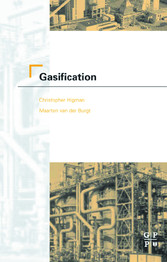Search and Find
Service
Front cover
1
copyright
5
Contents
6
Preface
8
COMPANION WEBSITE
10
TERMINOLOGY
10
ACKNOWLEDGMENTS
11
1. Introduction
12
1.1 HISTORICAL DEVELOPMENT OF GASIFICATION
12
1.2 GASIFICATION TODAY
16
2. The Thermodynamics of Gasification
20
2.1 REACTIONS
21
2.2 THERMODYNAMIC MODELING OF GASIFICATION
24
2.2.1 Basic Data
25
2.2.2 Equations
27
2.2.3 Variables
28
2.3 DEDUCTIONS FROM THE THERMODYNAMIC MODEL
28
2.3.1 Effect of Pressure
28
2.3.2 Effect of Temperature
30
2.3.3 Fuel Footprint
31
2.3.4 Surprises in Calculations
34
2.4 OPTIMIZING PROCESS CONDITIONS
34
2.4.1 Process Indicators
35
2.4.2 Optimum Operating Point
36
3. The Kinetics of Gasification and Reactor Theory
40
3.1 KINETICS
40
3.1.1 Devolatilization
41
3.1.2 Volatiles Combustion
42
3.1.3 Char Gasification
43
3.2 REACTOR THEORY
46
3.3 APPLICATIONS TO REACTOR DESIGN
49
3.3.1 Modeling
49
4. Feedstocks and Feedstock Characteristics
52
4.1 COALS AND COKE
52
4.1.1 Formation of Coal
53
4.1.2 Coal Analysis
53
4.1.3 Other Minerals in Coal
58
4.1.4 Other Properties
59
4.1.5 Ash Properties
60
4.1.6 Coke
64
4.1.7 Petroleum Coke
64
4.2 LIQUID AND GASEOUS FEEDSTOCKS
64
4.2.1 Refinery Residues
64
4.2.2 Other Liquid Feedstocks
74
4.2.3 Natural Gas
77
4.2.4 Other Gaseous Feedstocks
78
4.3 BIOMASS
78
4.3.1 Properties of Biomass
79
4.3.2 Black Liquor
81
4.3.3 Biomass Production
83
4.3.4 Development Potential
84
4.4 WASTES
87
4.4.1 Solid Waste
87
4.4.2 Liquid Wastes
89
5. Gasification Processes
96
5.1 MOVING- BED PROCESSES
98
5.1.1 The Lurgi Dry Ash Process
99
5.1.2 British Gas/ Lurgi ( BGL) Slagging Gasifier
105
5.1.3 Ruhr 100
108
5.2 FLUID- BED GASIFIERS
109
5.2.1 Common Issues
110
5.2.2 The Winkler Process
112
5.2.3 The High- Temperature Winkler ( HTW) Process
114
5.2.4 Circulating Fluid- Bed ( CFB) Processes
116
5.2.5 The KBR Transport Gasifier
116
5.2.6 Agglomerating Fluid- Bed Processes
118
5.2.7 Development Potential
119
5.3 ENTRAINED- FLOW GASIFIERS
120
5.3.1 General Considerations
124
5.3.2 The Koppers- Totzek Atmospheric Process
128
5.3.3 Shell Coal Gasification Process ( SCGP) and Prenflo Process
129
5.3.4 The Noell Process
131
5.3.5 The Texaco Process
133
5.3.6 The E- Gas Process
136
5.3.7 The CCP Gasifier
137
5.3.8 The EAGLE Gasifier
139
5.4 OIL GASIFICATION AND PARTIAL OXIDATION OF NATURAL GAS
139
5.4.1 The Texaco Gasification Process
140
5.4.2 The Shell Gasification Process ( SGP)
144
5.4.3 Lurgi’s Multipurpose Gasification Process ( MPG)
151
5.4.4 New Developments
153
5.4.5 Process Safety
157
5.5 BIOMASS GASIFICATION
158
5.5.1 Fluid- Bed Processes
159
5.5.2 Twin Fluid- Bed Steam Gasification
161
5.5.3 Pyrolysis Processes
164
5.5.4 Other Processes
166
5.6 GASIFICATION OF WASTES
166
5.6.1 Coal Gasifiers in Waste Service
167
5.6.2 Purpose Developed Processes
168
5.7 BLACK LIQUOR GASIFICATION
170
5.7.1 The Chemrec Process
170
5.7.2 MTCI "Pulse Enhanced" Steam Reformer
171
5.8 MISCELLANEOUS PROCESSES
172
5.8.1 In situ Gasification
172
5.8.2 Molten Iron Processes
173
5.8.3 Plasma Gasification
173
5.8.4 Hydrogasification
173
6. Practical Issues
182
6.1 EFFECT OF PRESSURE
182
6.2 PRESSURIZATION OF COAL
184
6.2.1 Dry- Coal Feeding with Lock Hoppers
184
6.2.2 Pumping Coal as a Coal- Water Slurry
188
6.2.3 Wet Lock Hoppers
190
6.2.4 Tall Hoppers for Pressurizing
191
6.2.5 Miscellaneous Methods of Pressurizing
193
6.3 COAL SIZING AND DRYING
194
6.3.1 Coal Sizing
194
6.3.2 Coal Drying
194
6.4 REACTOR DESIGN
195
6.4.1 Reactor Embodiment
195
6.4.2 Reactor Containment and Heat Loss
196
6.5 BURNERS
202
6.6 SYNTHESIS GAS COOLING
203
6.6.1 Quenching
204
6.6.2 Synthesis Gas Coolers
207
6.6.3 Syngas Cooling in Oil Service
208
6.7 PARTICULATE REMOVAL
211
6.7.1 Dry Solids Removal
211
6.7.2 Wet Solids Removal
212
6.8 PROCESS MEASUREMENT
212
6.8.1 Gasification Temperature Measurement
212
6.8.2 Temperature Control
215
6.8.3 Gas Analysis
215
6.9 TRACE COMPONENTS OF RAW SYNTHESIS GAS
219
6.9.1 Sulfur Compounds
219
6.9.2 Nitrogen Compounds
220
6.9.3 Chlorine Compounds
223
6.9.4 Unsaturated Hydrocarbons
223
6.9.5 Oxygen
223
6.9.6 Formic Acid
224
6.9.7 Carbon
224
6.9.8 Metal Carbonyls
225
6.9.9 Mercury
228
6.9.10 Arsenic
229
6.10 CHOICE OF OXIDANT
230
6.10.1 Effect of Oxidant on the Gasification Process
230
6.10.2 Equipment Sizing and Gas Flow Rate
232
6.10.3 Parasitic Power
233
6.10.4 Deductions
234
6.11 CORROSION ASPECTS
234
6.11.1 Sulfur
234
6.11.2 Hydrogen
235
6.11.3 Chlorides
235
6.11.4 Metal Dusting
236
7. Applications
242
7.1 CHEMICALS
242
7.1.1 Ammonia
243
7.1.2 Methanol
250
7.1.3 Hydrogen
254
7.1.4 Carbon Monoxide and Oxo- Alcohols
260
7.2 SYNFUELS
263
7.2.1 Gas to Liquids
265
7.2.2 SNG from Coal
269
7.3 POWER
270
7.3.1 Comparison with Combustion
271
7.3.2 State- of- the- Art IGCC
278
7.3.3 Advanced Cycles
281
7.3.4 Flue Gas Treatment
289
7.3.5 Miscellaneous
298
7.3.6 Energy Storage
298
8. Auxiliary Technologies
304
8.1 OXYGEN SUPPLY
304
8.1.1 Technologies
304
8.1.2 Pipeline and Other Supply Possibilities
308
8.2 SYNTHESIS GAS TREATING
309
8.2.1 Selection Criteria
309
8.2.2 Absorption Systems
311
8.2.3 Adsorption Systems
320
8.2.4 Membrane Systems
323
8.2.5 Further Developments
326
8.2.6 Biomass Syngas Treating
326
8.3 CO SHIFT
326
8.3.1 Clean Gas Shift
327
8.3.2 Raw Gas Shift
328
8.4 SULFUR RECOVERY
329
8.4.1 The Claus Process
329
8.4.2 Tail Gas Treatment
332
8.4.3 Integration in an IGCC
334
8.4.4 Sulfuric Acid
334
9. Economics, Environmental, and Safety Issues
340
9.1 ECONOMICS
340
9.2 ENVIRONMENTAL ISSUES
346
9.2.1 Gaseous Effluents
347
9.2.2 Greenhouse Gases
350
9.2.3 Liquid Effluents
355
9.2.4 Solid Effluents
356
9.2.5 Waste Gasification
358
9.3 SAFETY
358
9.3.1 Start- Up
359
9.3.2 Shutdown
359
9.3.3 Spontaneous Combustion
359
9.3.4 Toxic and Asphyxiating Materials
360
9.3.5 Oxygen
360
10. Gasification and the Future
366
Appendix A: Companion Website
370
Appendix B: Conversion Factors
372
Appendix C: Emissions Conversion Factors
378
Appendix D: Guidelines for Reporting Operating Statistics for Gasification Facilities
380
Appendix E: Basis for Calculations
384
Nomenclature
386
List of Names and Abbreviations
388
Index
392
All prices incl. VAT











